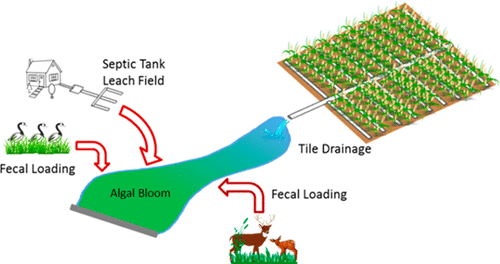当前位置:
X-MOL 学术
›
Environ. Sci. Technol.
›
论文详情
Our official English website, www.x-mol.net, welcomes your feedback! (Note: you will need to create a separate account there.)
Tile Drainage and Anthropogenic Land Use Contribute to Harmful Algal Blooms and Microbiota Shifts in Inland Water Bodies
Environmental Science & Technology ( IF 11.4 ) Pub Date : 2018-07-16 , DOI: 10.1021/acs.est.8b03269 Igor Mrdjen 1 , Siobhan Fennessy 2 , Alex Schaal 2 , Richard Dennis 2 , Joan L. Slonczewski 2 , Seungjun Lee 1 , Jiyoung Lee 1, 3
Environmental Science & Technology ( IF 11.4 ) Pub Date : 2018-07-16 , DOI: 10.1021/acs.est.8b03269 Igor Mrdjen 1 , Siobhan Fennessy 2 , Alex Schaal 2 , Richard Dennis 2 , Joan L. Slonczewski 2 , Seungjun Lee 1 , Jiyoung Lee 1, 3
Affiliation

|
Freshwater harmful algal blooms (HABs), driven by nutrient inputs from anthropogenic sources, pose unique risks to human and ecological health worldwide. A major nutrient contributor is agricultural land use, specifically tile drainage discharge. Small lakes and ponds are at elevated risk for HAB appearance, as they are uniquely sensitive to nutrient input. HABs introduce exposure risk to microcystin (MC), hepatotoxic and potentially carcinogenic cyanotoxins. To investigate the impact of anthropogenic land use on small lakes and ponds, 24 sites in central Ohio were sampled over a 3-month period in late summer of 2015. MC concentration, microbial community structure, and water chemistry were analyzed. Land use intensity, including tile drainage systems, was the driver of clustering in principle component analysis, ultimately contributing to nutrient deposition, a driver of HABs. Relative abundance of HAB-forming genera was correlated with elevated concentrations of nitrate and soluble reactive phosphate. One location (FC) showed MC concentrations exceeding 875 μg/L and large community shifts in ciliates (Oligohymenophorea) associated with hypoxic conditions. The prokaryotic community at FC was dominated by Planktothrix sp. These results demonstrate the impact of HABs in small lakes and ponds, and that prevailing issues extend beyond cyanotoxins, such as cascading impacts on other trophic levels.
中文翻译:

瓷砖排水和人为土地使用造成内陆水体中有害藻华和微生物群落转变
在来自人为来源的营养输入的驱动下,淡水有害藻华(HABs)对全球人类和生态健康构成了独特的风险。主要的养分贡献者是农业土地利用,特别是瓷砖排水。小型湖泊和池塘由于对养分输入特别敏感,因此HAB出现的风险较高。HAB会导致暴露于微囊藻毒素(MC),肝毒性和潜在致癌性氰毒素的风险。为了调查人为土地利用对小湖和池塘的影响,在2015年夏末的三个月内,对俄亥俄州中部的24个站点进行了采样。分析了MC浓度,微生物群落结构和水化学。土地使用强度(包括瓷砖排水系统)是原则成分分析中聚类的驱动因素,最终有助于养分沉积,这是HAB的驱动力。HAB形成属的相对丰度与硝酸盐和可溶性反应性磷酸盐的浓度升高相关。一个地点(FC)显示MC浓度超过875μg/ L,并且与低氧状况相关的纤毛虫(寡聚磷尿素)发生了较大的群落转移。FC的原核社区主要由Planktothrix sp。这些结果证明了HABs在小湖和池塘中的影响,并且普遍存在的问题超出了氰毒素的范围,例如对其他营养级联的影响。
更新日期:2018-07-18
中文翻译:

瓷砖排水和人为土地使用造成内陆水体中有害藻华和微生物群落转变
在来自人为来源的营养输入的驱动下,淡水有害藻华(HABs)对全球人类和生态健康构成了独特的风险。主要的养分贡献者是农业土地利用,特别是瓷砖排水。小型湖泊和池塘由于对养分输入特别敏感,因此HAB出现的风险较高。HAB会导致暴露于微囊藻毒素(MC),肝毒性和潜在致癌性氰毒素的风险。为了调查人为土地利用对小湖和池塘的影响,在2015年夏末的三个月内,对俄亥俄州中部的24个站点进行了采样。分析了MC浓度,微生物群落结构和水化学。土地使用强度(包括瓷砖排水系统)是原则成分分析中聚类的驱动因素,最终有助于养分沉积,这是HAB的驱动力。HAB形成属的相对丰度与硝酸盐和可溶性反应性磷酸盐的浓度升高相关。一个地点(FC)显示MC浓度超过875μg/ L,并且与低氧状况相关的纤毛虫(寡聚磷尿素)发生了较大的群落转移。FC的原核社区主要由Planktothrix sp。这些结果证明了HABs在小湖和池塘中的影响,并且普遍存在的问题超出了氰毒素的范围,例如对其他营养级联的影响。

























 京公网安备 11010802027423号
京公网安备 11010802027423号